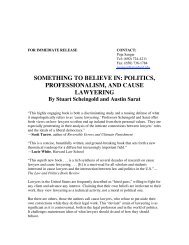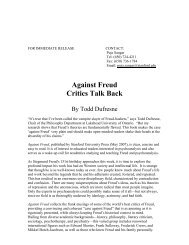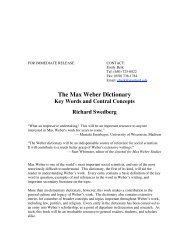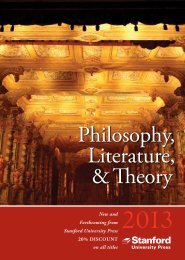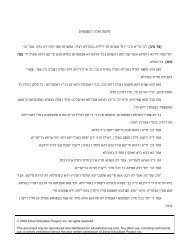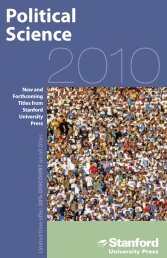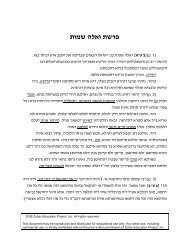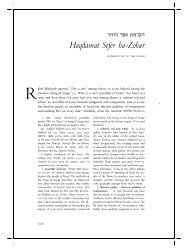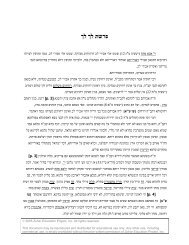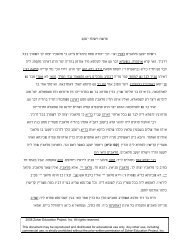Front Matter (PDF) - Stanford University Press
Front Matter (PDF) - Stanford University Press
Front Matter (PDF) - Stanford University Press
You also want an ePaper? Increase the reach of your titles
YUMPU automatically turns print PDFs into web optimized ePapers that Google loves.
the divergence between these two tendencies within Kabbalah, we see<br />
In<br />
and abstractionist elements strugglingwithin the emergingself-articu-<br />
mythic<br />
of the mystical spirit. In raisingall to the very heights of the se®rotic<br />
lation<br />
the Catalonians were votingfor abstraction, a Kabbalah that led the<br />
world,<br />
to experience a God not entirely removed from the rari®ed transpersonal<br />
mystic<br />
deity of the Jewish philosophers. The Castilians may have incorporated<br />
aspects of Gerona's Neoplatonism, but their spirit is entirely different.<br />
some<br />
in¯uenced in part by renewed contact with more mythically-oriented<br />
Perhaps<br />
elements, and in part re¯ectingalso the romantic troubadour ethos<br />
Ashkenazic<br />
the surroundingculture, they write in a spirit far from that of philosophy.<br />
of<br />
we ®nd a strong emphasis on the theurgic, quasi-magical effect of<br />
Here<br />
activity on the inner state of the Godhead, and its ef®cacy in<br />
kabbalistic<br />
divine unity and thus showeringdivine blessingupon the lower<br />
bringingabout<br />
Their depictions of the upper universe are highly colorful, sometimes<br />
world.<br />
earthy. The fascination with both the demonic and the sexual that characterizes<br />
even<br />
their work lent to Kabbalah a dangerous and close-to-forbidden edge<br />
undoubtedly served to make it more attractive, both in its own day and<br />
that<br />
later generations. 2<br />
throughout<br />
last quarter of the thirteenth century was a period of great creative<br />
The<br />
amongthe kabbalists of Castile. The se®rotic KabbalahÐas detailed<br />
expansion<br />
the works of such well-known ®gures as Moses de LeoÂn, Todros Abula®a,<br />
in<br />
Gikatilla, Isaac Ibn Sahula, Joseph ben Shalom Ashkenazi, Joseph An-<br />
Joseph<br />
and Joseph of Hamadan, all dating from the period between 1280 and<br />
gelino,<br />
a considerable and highly varied body of writing, even leav-<br />
1310Ðconstitutes<br />
the Zohar itself. It was within this circle that fragments of a more<br />
ingaside<br />
composition, written mostly in lofty and mysterious Aramaic rather<br />
poetic<br />
Hebrew, ®rst began to circulate. These fragments, composed within one<br />
than<br />
two generations but edited over the course of the following century and a<br />
or<br />
The emergence of kabbalistic teaching is more complex and obscure than has been<br />
2.<br />
in the precedingparagraphs. The relationship between Kabbalah and certain late<br />
described<br />
of midrashic writingis still not entirely clear. The nature and degree of contact<br />
forms<br />
early kabbalists and the German Hasidic circles, especially as re¯ected in the<br />
between<br />
of Rabbi Eleazar of Worms (ca. 1165±ca. 1230), continues to puzzle scholars. The<br />
writings<br />
of abstract mystical writings known as Sifrei ha-Iyyun, or Books of Contemplation, ®ts<br />
group<br />
into this puzzle, but its precise date and relationship to other parts of the pre-<br />
somewhere<br />
corpus is still debated by scholars. The sources of the highly distinctive school of<br />
Zoharic<br />
or ``ecstatic'' Kabbalah taught by Rabbi Abraham Abula®a (1240±after 1292),<br />
``prophetic''<br />
havinglittle connection to the Zohar, also would require treatment in a full picture of<br />
while<br />
emergence of kabbalistic thought. But this very brief treatment of major schools and<br />
the<br />
should suf®ce to set forth the context out of which the Zohar emerged.<br />
themes<br />
Introduction<br />
xl<br />
half, are known to the world as the Zohar.



